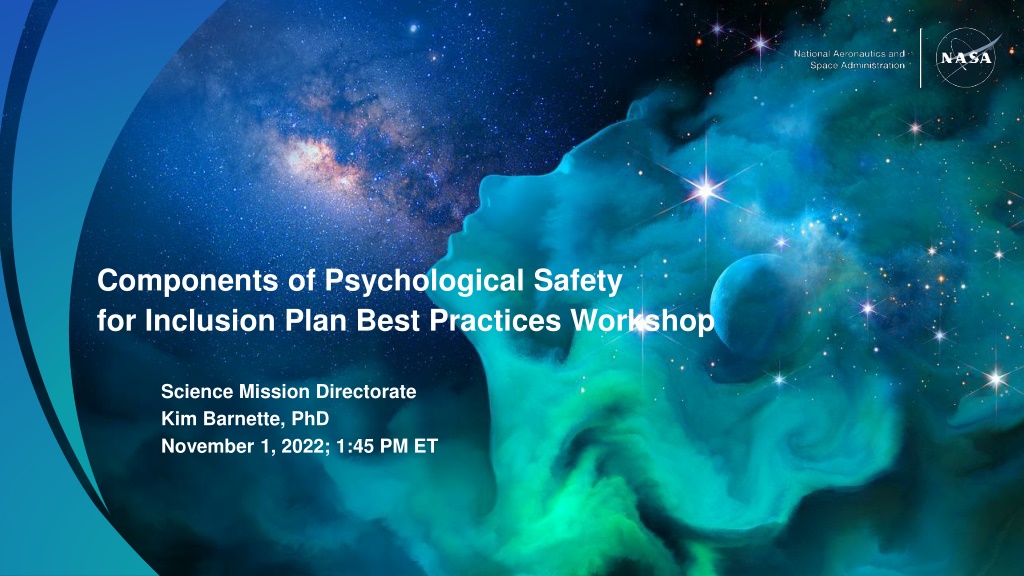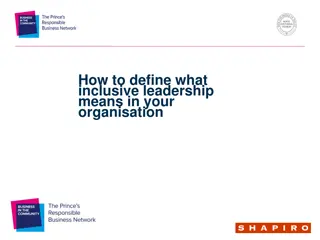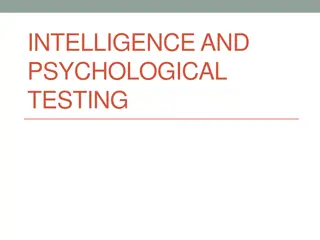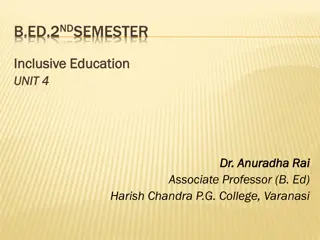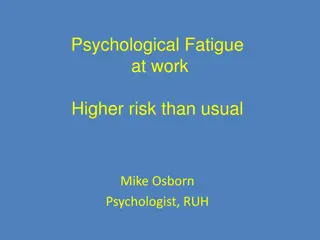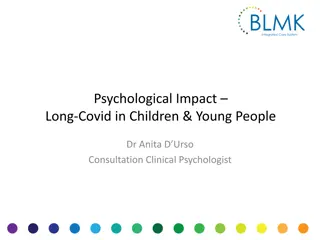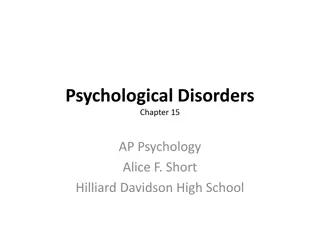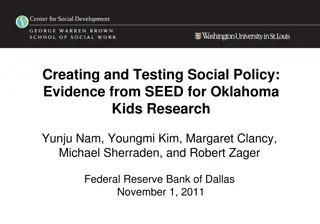Understanding Psychological Safety for Inclusive Environments
This presentation explores the components of psychological safety according to current research, emphasizing its role in fostering inclusive environments. It delves into the NASA Science Strategic Approach, defines psychological safety based on Dr. Timothy Clark's 4-stage model, discusses team psychological safety and effectiveness, and highlights the impact of psychological safety on team performance and efficacy.
Uploaded on Nov 22, 2024 | 0 Views
Download Presentation

Please find below an Image/Link to download the presentation.
The content on the website is provided AS IS for your information and personal use only. It may not be sold, licensed, or shared on other websites without obtaining consent from the author. Download presentation by click this link. If you encounter any issues during the download, it is possible that the publisher has removed the file from their server.
E N D
Presentation Transcript
Components of Psychological Safety for Inclusion Plan Best Practices Workshop Science Mission Directorate Kim Barnette, PhD November 1, 2022; 1:45 PM ET
Content Summary This presentation provides an overview of the components of psychological safety as defined in current research, and the connection to inclusive environments. I. NASA Science Strategic Approach II. What is Psychological Safety? III.Team Psychological Safety and Team Effectiveness IV.Connection to Inclusive Environments V. Key Variables Related to Psychological Safety VI.References 2
What is Psychological Safety? The 4-stage model designed by Dr. Timothy Clark, Oxford University social scientist, defines psychological safety as a condition in which human beings feel (1) included, (2) safe to learn, (3) safe to contribute, and (4) safe to challenge the status quo all without fear of being embarrassed, marginalized, or punished in some way. (Clark, 2019) Safety to Belong Safety to Learn Safety to Contribute Safety to Challenge Informal admittance to the team. Feeling connected and included. Engagement in the discovery process. Freedom to ask questions. Invitation and expectation to perform. Autonomy exists in this space. Ability to challenge the status quo, without fear of reprisal. 4
Team Psychological Safety and Team Effectiveness Team psychological safety is a shared belief that people feel safe about the interpersonal risks that arise concerning their behaviors in a team context (Edmondson, 2018). Project Aristotle, which explored over 250 team-level variables, found that successful Google teams have five elements in common: psychological safety, dependability, structure and clarity, meaning, and impact of work (Google, 2015). The findings argue that psychological safety is the most critical factor and a prerequisite to enabling the other four elements. In the last decade, the concept of psychological safety started attracting attention as a primary factor in predicting team effectiveness. 5
Team Psychological Safety and Team Effectiveness continued Kim, S., Lee, H., and Connerton, T. P., (2020) published results from their study that did not support one of their hypotheses that psychological safety directly affects team effectiveness. This result is consistent with the claims of Edmondson (2012, 2018). Psychological safety is the engine, not fuel for performance. If individuals are under an atmosphere that highly values their ideas and actions, employees can adapt themselves even to challenging tasks. A team s psychological safety promotes team learning and consequently increases the team s effectiveness. Also, the favorable climate promotes the team s efficacy and contributes to the performance of the team. 6
Connection to Inclusive Environments From Dr. Timothy Clark (Clark, 2019) : The 4 stages of psychological safety are a universal pattern that reflects the natural progression of human needs in social settings. When teams, organizations, and social units of all kinds progress through the 4 stages, they create deeply inclusive environments, accelerate learning, increase contribution and performance, and stimulate innovation. Psychological safety has proved to be a primary indicator of true inclusion as evidenced by various sociological, leadership, and psychological studies. Psychological safety measurement is the current tool that is used to measure inclusion beyond the surface in the DEI space. These measures can aid with baselining and identifying successful efforts that will help create an environment that fully embodies the values and the principles of NASA s Core Value of Inclusion 7
Key Variables Related to Psychological Safety (based on literature review) 8
References 1. Clark, T. R. (2019). The 4 Stages of Psychological Safety. http://adigaskell.org/2019/11/17/the-4-stages-of-psychological-safety/ 2. Edmondson, A. C. (2012). Teaming: How Organizations Learn, Innovate, and Compete in the Knowledge Economy. Hoboken, NJ: John Wiley & Sons. 3. Edmondson, A. C. (2018). The Fearless Organization: Creating Psychological Safety in the Workplace for Learning, Innovation, and Growth. Hoboken, NJ: John Wiley & Sons 4. Kim, S., Lee, H., and Connerton, T. P. (2020). How Psychological Safety Affects Team Performance: Mediating Role of Efficacy and Learning Behavior. https://doi.org/10.3389/fpsyg.2020.01581 5. Newman, A., Donohue R., Eva, N. (2017). Psychological safety: A systematic review of the literature. Human Resource Management Review, http://dx.doi.org/10.1016/j.hrmr.2017.01.001 9
Questions? 10
